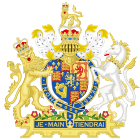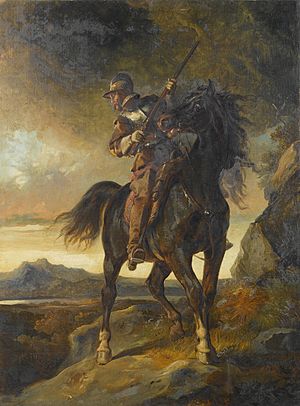Moss-trooper facts for kids
Quick facts for kids Moss Troopers Act 1662 |
|
|---|---|
| Act of Parliament | |

|
|
| Long title | An Act for preventing of Theft and Rapine upon the Northern Borders of England |
| Citation | 14 Cha. 2. c. 22
|
| Dates | |
| Royal assent | 19 May 1662 |
| Commencement | 29 September 1662 |
| Expired | 28 September 1667 |
| Repealed | 28 July 1863 |
| Other legislation | |
| Amended by | Moss Troopers Act 1666 |
| Repealed by | Statute Law Revision Act 1863 |
|
Status: Repealed
|
|
| Text of statute as originally enacted | |
| Moss Troopers Act 1666 | |
|---|---|
| Act of Parliament | |

|
|
| Long title | An Act to continue a former Act for preventing of Thefte and Rapine upon the Northerne Borders of England. |
| Citation | 18 & 19 Cha. 2. c. 3
|
| Dates | |
| Royal assent | 18 January 1667 |
| Commencement | 21 September 1666 |
| Expired | 28 September 1673 |
| Repealed | 28 July 1863 |
| Other legislation | |
| Amends | Moss Troopers Act 1662 |
| Repealed by | Statute Law Revision Act 1863 |
|
Status: Repealed
|
|
| Text of statute as originally enacted | |
| Moss Troopers Act 1677 | |
|---|---|
| Act of Parliament | |

|
|
| Long title | An Act for continuance of two former Acts for preventing of Theft and Rapine upon the Northerne Borders of England. |
| Citation | 29 & 30 Cha. 2. c 2 |
| Dates | |
| Royal assent | 20 March 1678 |
| Expired | 2 July 1687 |
| Repealed | 28 July 1863 |
| Other legislation | |
| Repealed by | Statute Law Revision Act 1863 |
|
Status: Repealed
|
|
| Text of statute as originally enacted | |
| Moss Troopers Act 1685 | |
|---|---|
| Act of Parliament | |

|
|
| Long title | An Act for Continuance of Three former Acts for Preventing of Theft and Rapine upon the Northerne Borders of England. |
| Citation | 1 Ja. 2. c. 14 |
| Dates | |
| Royal assent | 27 June 1685 |
| Repealed | 28 July 1863 |
| Other legislation | |
| Repealed by | Statute Law Revision Act 1863 |
|
Status: Repealed
|
|
| Text of statute as originally enacted | |
| Moss Troopers Act 1695 | |
|---|---|
| Act of Parliament | |

|
|
| Long title | An Act to continue Foure former Acts for preventing Theft and Rapine upon the Northerne Borders of England. |
| Citation | 7 & 8 Will. 3. c. 17 |
| Dates | |
| Royal assent | 10 April 1696 |
| Other legislation | |
| Repealed by | Statute Law Revision Act 1867 |
|
Status: Repealed
|
|
| Text of statute as originally enacted | |

Moss-troopers were groups of outlaws who caused trouble in the middle of the 17th century. They operated in the border lands between Scotland and the northern English counties of Northumberland and Cumberland. These groups were active during the time when England was a republic (the Commonwealth of England) and continued for a while after the king returned to power (the Restoration).
Contents
Who Were the Moss-troopers?
Moss-troopers were a lot like the earlier Border reivers. These reivers had caused problems in the same lawless region during the 1500s. The moss-troopers didn't just appear overnight. They slowly emerged from the long-standing social and political issues of the border area.
Historical records suddenly mention them, which might make it seem like they popped up quickly. However, the first law passed to stop them, the Moss Troopers Act of 1662, stated that moss-troopers had been a problem for a long time.
Laws Against Moss-troopers
The government passed several laws to try and stop the moss-troopers. These laws were called the Moss Troopers Acts.
The 1662 Act
The first important law was the Moss Troopers Act of 1662. It was created to prevent "Theft and Rapine" (stealing and violent crime) in the northern border areas of England. This law was meant to control the outlaws.
Tougher Punishments in 1666
When the 1662 law was about to end, the English Parliament passed the Moss Troopers Act of 1666. This new law made punishments much tougher. If someone was found guilty, they could face the death penalty.
The law also allowed judges to send these thieves and criminals from Northumberland or Cumberland far away. They could be sent to America, where they had to stay and were not allowed to return. This was a way to get rid of them permanently.
Later Acts to Continue Control
The problem of moss-troopers continued, so more laws were passed to keep the earlier acts in force. These included:
- The Moss Troopers Act of 1677
- The Moss Troopers Act of 1685
- The Moss Troopers Act of 1695
These acts showed that the government had to keep fighting against these groups for many years. All these laws were eventually removed from the law books in 1863 and 1867.
Life as a Moss-trooper
Many moss-troopers were soldiers who had left their armies or were no longer needed after the Wars of the Three Kingdoms. These wars involved fighting across England, Scotland, and Ireland. These former soldiers kept their weapons and became outlaws.
They often attacked both regular people and soldiers who supported Parliament. They would steal supplies during the Royalist uprising of 1653 to 1654. During this time, English Parliamentarian troops were in Scotland.
Moss-troopers usually worked in small groups. They operated in the areas around the Scottish Highlands or in the border regions. Many Scottish landowners complained about them stealing cattle. Their actions sometimes led to military attacks against the Highlands as a whole.
Why They Fought
Some moss-troopers might have had more than just money as a reason for their actions. They might have also wanted to resist the English army that was occupying Scotland at the time. This was similar to how Irish groups called "tories" resisted English control in Ireland.
See also
- Rapparees – Irish fighters who sometimes turned to stealing cattle and demanding money for "protection" from theft.
- Iain Dubh Camshròn (Sergent Mòr) – A Scottish outlaw who continued fighting after a rebellion in 1745. He was later caught and executed for stealing cattle.

